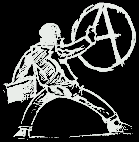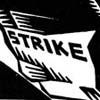|
|||||||||||||
|
The Working Class Holiday of Revolt and Rebellion By Punkerslut
The Origins of the First Labor Day -- May Day
On April 21, in the year 1856 in Australia, workers went on a general strike. The day was to be a celebration of Labor, where the streets would be seized by the working people and used in common, even if just for one day. It was used for agitating for the Eight-Hour Day and for organizing laborers into unions. [*1] The celebration was repeated again and again with great success The idea was imported into the United States, where it would receive widespread recognition. In the year 1886, at Haymarket Square in Chicago, 200,000 workers marched for the Eight-Hour Day on May 1st. On May 4th, A police officer, or an unknown individual whom the police refused to apprehend, threw a bomb into the crowd, which led to police officers firing indiscriminately at participants of the demonstration. [*2] The bomb went off and the smoke cleared, but for a full two minutes, police officers walked through the streets performing execution killings of unionists. [*3] Police officers ignored the bomb-thrower, but they had time to grab eight Anarchists who were giving speeches or organizing unions. This has been called throughout history The Haymarket Massacre. To quote the actual police report of the incident...
The Meaning of May Day
This is the significance of May Day: it is anti-Capitalist in its demands for unionism and the Eight-Hour Day, just as much as it is anti-government in its hatred of police injustice and state repression. It is a tragedy with the two most characteristic individuals of the century -- a police officer who shoots into crowds and openly claims that this is the expected behavior, and a working-class individual, marching with others in a collective, against the tyrannies of the Capitalist system. In one single event, all of the animosities against government and capitalist authority are expressed by common, ordinary people organized into a mass protest. That is the legacy of May Day, the true day of labor. May 1st has since been recognized internationally as a holiday of the workers against all oppressive systems. Eight Anarchists were arrested for the act of throwing the bomb at the Haymarket Square. During the trial, the police admitted that none of the eight accused had thrown the bomb: August Spies, Albert Parsons, Adolph Fischer, George Engel, Louis Lingg, Michael Schwab, Samuel Fielden, and Oscar Neebe. Of the eight accused Anarchists, all were found guilty, four being executed, one committing suicide, one sentenced to fifteen years, and two being pardoned. More than half of the accused were tireless editors and writers, the others being public speakers and organizers. Art Young, one of the witnesses of Albert Parsons shortly before he was executed, gave this description of his final moments, "Parsons sat writing at a table piled with books and papers. He reminded me of a country editor -- and he had edited a paper in Waco, Tex., before he came to Chicago." [*5] For a single person who threw a bomb, the eight most active Anarchists of Chicago were grabbed. The pardon of the two was by Governor John Altgeld, who said...
In Forest Home Cemetery, a statue built in 1890 commemorates the Anarchists who were killed during the massacre, with the following epitaph on the concrete base: "The day will come when our silence will be more powerful than the voices you are throttling today." [*7] Another statue was built in 1889 to honor the one police officer who was immediately killed by the blast, Mathias Degan. This statue has been repeatedly targeted by protesters and activists. It was blown up twice by the Weathermen, once in 1969 and again after it was rebuilt in 1970. [*8] The statue has been rebuilt and rededicated by the Chicago Police, as recently as 2007, where the confessed, two-minutes of executions in the streets by police is described as "a gun battle" between "police and armed protesters." [*9] Where is My Labor Day Now? What Have They Done With it?
May 1st is not recognized as Labor Day in the United States, or in other Capitalist Nations. Instead, it is recognized on September 5th. It is best to keep those old memories out of the minds of the people -- how could a politician make an official holiday out of an event where police officers shot workers in the streets? The first labor day passed against the workers' true holiday was in Oregon, in 1887. All of the institutional forces of Capitalism stood up to defend some random day in September, and not May 1st, as the day to celebrate the working class. A meaningless day, connected with nothing, having no meaning at all, and celebrating nothing. Even the conservative American Federation of Labor (AFL) opposed May 1st celebrations; to quote their president, Samuel Gompers...
The law was enacted after the Pullman Strike led by Eugene V. Debs, where union organizers were thrown into prisons on rigged charges and where 12,000 soldiers opened fired on crowds of striking workers. [*11] But Debs was a Socialist, while Samuel Gompers and the AFL were openly anti-Socialist. The holiday enacted was proof of the alliance between conservative "labor" organizations and oppressive government, both of them devoted to supporting the Capitalist system. Naturally, Samuel Gompers celebrated the September holiday for labor, while his so-called "fellow working people" lay dead from military gunfire. May First, the beginning of spring, the opening act to summer, the sign and symbol of the coming heat, the increasing anger and rage -- this was replaced with September Fifth, the end of summer, the cooling of the skies and the breeze, the calm and complacency of a forest subjugated by snow and frost. It was once held on the first of the month, as though the first and most essential part of civilization were being celebrated. Now, it is held on the fifth, neither a beginning nor an ending, it's just an intermediate point in the whole month. This was not enough, though. In 1921, Veterans of Foreign Wars (VFW), began celebrating a counter-holiday to May Day. The day of May First they proclaimed to be the holiday of "Americanization Day." A patriotic, military organization sponsored this holiday as "a counter to the Communists' May 1 celebration of the Russian Revolution." [*12] That's actually wrong, as the Russian Revolution that overthrew the tzar was in February, and the one that created the Bolshevik Dictatorship was in October. [*13] No matter what "Russian Revolution" they're talking about, May is a fairly uneventful month in the whole timeline of Russian Revolutionary history. The VFW is protesting a "Communist holiday," one where it is completely ignorant of its history. May 1st became significant because of the march for the Eight-Hour Day in Chicago in 1886, and legendary because of the killings by the police and the fixed trials. It has nothing at all to do with the Russian Revolution. They can't even come out and say exactly what happened on that day, May 1st, because it would probably make them feel guilty -- they're protesting the remembrance of the victims of police violence, those who were killed because they struggled for the Eight-Hour Day and working class solidarity. Of course, VFW will just say that May 1st has to do with the Russian Revolution, and then they can evade that whole messy business of what they're actually protesting. According to VFW, "On May 1, 1930, 10,000 VFW members staged a rally at New York's Union Square to promote patriotism." [*14] In 1954, US President Dwight D. Eisenhower signed a law adding the phrase "Under God" to the U.S. Pledge of Allegiance, which every child in the country is required to recite at school. [*15] Next year, in 1955, he signed another law requiring that the phrase "In God We Trust" appear on all American currency. [*16] [*17] From the group VFW, he took the holiday of Americanization Day, renaming it to Loyalty Day, to be celebrated on the first of May -- this is the official, government counter-holiday to May First. To quote Eisenhower...
That's right! Get the hell out of here, Child Health Day! It sounds like a Communist holiday anyway, since it implies healthcare for the undeveloped and powerless. The point of May First, according to a modern, Conservative writer, is "for the reaffirmation of loyalty to the United States and for the recognition of the heritage of American freedom." [*19] The signing of Loyalty Day was in July of 1958, but Eisenhower wasn't satisfied. On December 31st of that year, he added another holiday to be celebrated officially on the first of May: Law Day. [*20] Law Day is much more specific than mere bland patriotism, but strikes more at the core of revolutionary and radical idealism. To quote Eisenhower when he signed the bill, "I urge the people of the United States to observe Law Day with appropriate public ceremonies and by the reaffirmance of their dedication to our form of government and the supremacy of law in our lives." [*21] This is how a United States president celebrates a day when workers were butchered in the streets by police gunfire: Loyalty Day and Law Day. Learn to obey, and learn to love your obedience. Keeping Up the Lies With Other Presidents
The traditions of Loyalty Day and Law Day have been preserved by all of the presidents following Eisenhower. After Dwight Eisenhower as president, John F. Kennedy continued these traditions. On April 7, 1961, John F. Kennedy issued a proclamation to "to observe Monday, May 1, 1961, as Law Day, U.S.A.," choosing the day used as a remembrance for the victims of police brutality and fixed trials. The point of the day is "to foster a full understanding and appreciation of our liberties and of the legal and judicial institutions which protect them." [*22] On April 12, 1961, he also added Loyalty Day, as well, to the mix on May First, because "steadfast devotion to our country and our Constitution is indispensable" and "it is most appropriate that a special day be set aside each year for the affirmative expression of our loyalty to the United States of America." [*23] Loyalty Day was celebrated again in 1963, so that "all of our people may join in a reaffirmation of their loyalty to the United States of America." [*24] Law Day was also celebrated by Kennedy again in 1962 and in 1963. [*25] After John F. Kennedy's assassination, Lyndon B. Johnson became president, who likewise held a patriotic reverence for the days of Law and Loyalty. In 1964, Johnson devoted the day of the Haymarket martyrs to the devotion of law, because "Respect for law is the condition upon which our whole social order depends." [*26] Loyalty Day was celebrated, as well, because "The strength and vigor of our Nation is directly attributable to the dedication, devotion, and loyalty of its people..." [*27] In 1965, Lyndon Johnson celebrated Law Day, stating "our very lives, our liberty, and our rights to pursue our individual destinies are dependent upon our system of law..." [*28] Loyalty Day was also celebrated, with the day of the Anarchist and Communist-inspired May Day used again, because "In these times when misguided forces throughout the world publicly declare their intent to destroy our democratic way of life..." [*29] Richard Nixon is a memorable character in American history -- as president, tried to poison liberal reporters with LSD, his staff broke into a psychiatrist's office to steal files, and he even planned the firebombing of the Brookings Institute, a Liberal thinktank. [*30] In 1969, he celebrated Law Day, because "rising crime rates, urban rioting, and violent campus protests -- have impeded rather than advanced social justice. We must reverse the upward trend of lawlessness in our land." [*31] And, of course, you cannot forget the 1974 celebration of Loyalty day by Nixon, "It is patriotism which calls upon all of us to make personal sacrifices when our Nation is challenged from within or without." [*32] Gerald Ford continued the tradition of Law Day on 1975, "Let each of us reaffirm our devotion to and respect for the legal process..." [*33] And, Loyalty Day was not forgotten, either. In memory of that date remembering the rigged trials and the executions of writers and editors, "The United States has become the greatest Nation in history because of the loyalty of our people to our Constitution, to our laws, and to those ideals which they represent." [*34] Every president gave some speech about law and obedience on these days of "Law" and "Loyalty." Ronald Reagan remembers the police brutality victims of Chicago with, "let us make our observance of Loyalty Day one of reflection on all the profound good that our experiment in individual liberty and limited government has meant for the United States of America and for the hope of the world." [*35] George H. Bush celebrated Loyalty Day in 1989 as "an occasion for reaffirming our allegiance to the United States and our devotion for reaffirming our allegiance to the United States..." [*36] He also celebrated Law Day. [*37] His son, George W. Bush, followed suit, celebrating Loyalty Day [*38], as well as Law Day, where he stated...
Bill Clinton celebrated Loyalty Day [*40] and Law Day. [*41] So did Jimmy Carter. [*42] [*43] Even Barack Obama in 2009 issued a proclamation for Law Day, where "...we celebrate our commitment to the rule of law." Loyalty Day was celebrated, too, both days on May First, bumping the day of recognition of those persecuted for being Anarchists and union-organizers. After all, according to President Obama, "The young Republic committed itself to protecting the rights of life, liberty, and the pursuit of happiness for all citizens." [*44] Where Do We Go From Here?
Every single president since Eisenhower has kept these two "holidays" alive: Loyalty Day and Law Day. Imagine if you had given any of these presidents a simple history lesson. "Do you want me to obey the law, like Samuel Adams and George Washington who fought the forces of the state? Do you want me to be loyal to the United States government, in the way that Thomas Paine and Thomas Jefferson were loyal to the British monarchy?" What could they possibly respond with, except either lies or deception? Loyalty and the murder of workers in the streets. What does it really mean, when a day of massacres is celebrated as a day of patriotism and respect for law? Does that mean it is unpatriotic to oppose killing in the street? Does that mean I'm a radical, Communist revolutionary, just because I think it's unacceptable for police officers to murder unarmed people in crowds? Does that mean that this type of killing, these types of rigged trials and forged testimonies, is synonymous with "liberty"? Does that mean that every president, from Obama to Nixon, agrees with the acts of those police officers? Does that mean they really think we should be celebrating our "freedom" and our "patriotism," from a country whose police kill people and whose judges fix trials? It's implied, but it's not really stated. Something like that, the truth, would be politically indecent.
Punkerslut, Resources *1. "What Are the Origins of May Day?" by Rosa Luxemburg, 1894, Written: 1894. First published in Polish in Sprawa Robotnicza, Published: From Selected Political Writings of Rosa Luxemburg, translated by Dick Howard, Monthly Review Press, 1971, pages 315-16, Marxists.org.
|



